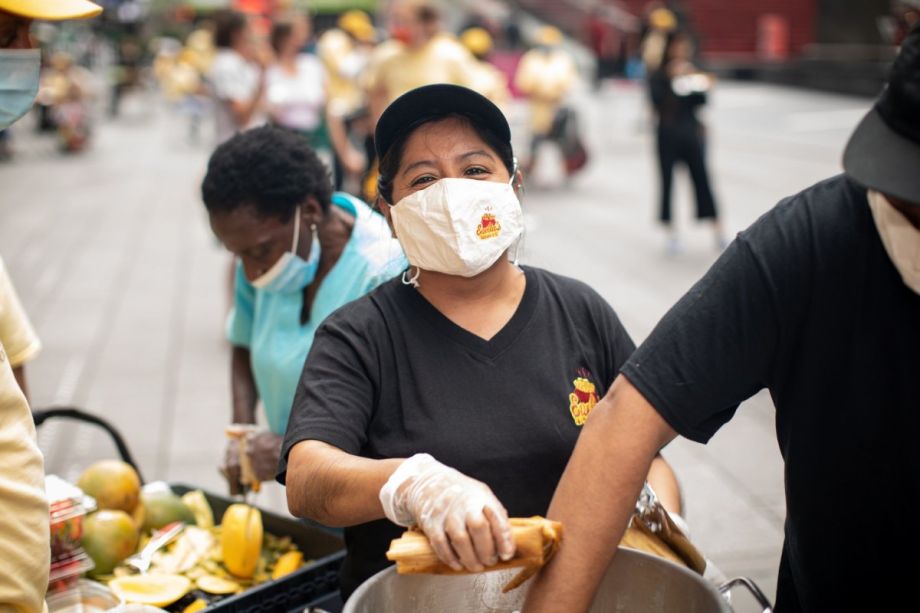Baker Yolfer Carvajal Quintero arrived at the Hot Bread Kitchen Incubator each day at 4 p.m. He had already worked a nine-hour shift in another bakery, but would work on testing and improving his recipes for another six hours. He was dreaming of launching his own bakery business based on his Colombian-Venezuelan roots and worked this schedule—with no days off—to make it a reality.
After three years, he was finally ready to leave his day job and focus on his own business. One month later, in March 2020, all of New York’s food businesses ground to a halt.
Yolfer took a week to make a plan of action. Using his network of contacts from the incubator kitchen, he pivoted to creating pastry boxes that could be delivered to homes or donated to frontline workers — a symbol of love and appreciation in a time of uncertainty and pain. They were also an emblem of the resiliency of food business workers, who are concerned with both their survival and the ongoing care of their communities.
During the pandemic, lines at food pantries filled both city blocks and local news media coverage, but smaller stories like Yolfer’s and other food systems workers’ were less seen and acknowledged. Community gardens continued to plant and grow food for sharing with their neighbors. Food distributors in the Maspeth Industrial Business Zone pushed to keep their workers while struggling with supply chain disruptions. While parts of the city shut down, workers in any part of the food spectrum worked tirelessly and innovated overnight to keep the city fed.
These stories of resilience at the local neighborhood scale show us who needs to be centered in creating solutions toward a more equitable food system. Emergency food has played a vital role in preventing hunger during the pandemic, but it will never build long-term success: the foundations of a healthy future lie in communities’ ability to sustainably feed themselves and build wealth through doing so.
As Forefront Fellows of the Urban Design Forum, we came together with a cohort of 25 activists, architects, designers, and public servants — in partnership with the New York City Mayor’s Office of Food Policy and the Department of City Planning — to help all New York neighborhoods gain equitable access to the capital, space and resources that enable a community-centered food system.
From food access to sovereignty
As was painfully demonstrated during the pandemic, New York City neighborhoods do not experience equitable access to good food.
Our policy choices interact with historical inequities and environmental factors to shape neighborhoods like Hunts Point –home to a vibrant local community and one of the largest food hubs in the country, as well as one of the highest rates of food insecurity. About 60% of the city’s produce and about half of the city’s meat and fish pass through Hunts Point for sale and distribution to retailers and communities, but the food never reaches the local area. Instead, its flow is directed by large-scale profit-maximizing corporations, who fail to serve the community while harming them through emissions and negative environmental impacts.
Historically, New York’s food policy has focused on remediating emergencies through food banks, fueled by the waste streams of food corporations and the agricultural industry. Hunts Point Market donates more than 15 million pounds of unsold food annually to food banks in the five boroughs and Westchester County, partnering with providers including City Harvest, Feeding Westchester and Food Bank For New York City. City Harvest operates a fleet of 23 refrigerated trucks, seven days a week, retrieving more than 200,000 pounds of food per day.
While valuable in a moment of crisis, this system is unfit for the long-term feeding of a city. It undercuts local food providers and diverts investment away from longer-term sustainable developments. It removes a community’s ability to choose how they feed themselves and forces them into dependence on the handoffs of industrial overproduction. Crucially, it also denies the community an opportunity to grow and share sustained wealth through food businesses, as the contracting, granting and professional building is held within these large-scale operations.
An emergency response was necessary to stem the rate of food insecurity during the worst of the pandemic. However, to address long-term, systemic and emergent food insecurity, we need to move beyond short-term food access to focus on solutions centered around community ownership of the food system.
This means supporting neighborhoods in developing their own self-sustaining mechanisms for feeding themselves, as well as investing across the food life cycle from community gardens to commissary kitchens and food cooperatives. With the right capital and infrastructure, bakers like Yolfer can feed their neighbors, build their businesses and sustain their communities.
Setting the table for multiple stakeholders
To create more infrastructure that addresses food insecurity in the long term, we must develop a new system of norms and practices for space usage, funding and city infrastructure. In New York City, multiple players have the authority to propose and enact these changes, including a number of government agencies with different expertise, priorities and mandates that affect how they approach the work.
An example of positive policy change is happening in the City’s food procurement for major institutions like hospitals and schools. Historically, the City has always been required to choose the lowest-priced vendors. This policy prevented small and mid-scale local producers from competing with larger-scale food distributors and multinational corporations. Through the Good Food Purchasing Plan, New York is incorporating a more mission-driven policy that prioritizes the benefits of local food purchasing over cut-price food. Local purchasing reduces the carbon emissions from transporting food over long distances, increases the nutritional impact of the food, and creates better support and infrastructure for local farms and distributors.
City government also managed a process that included multiple stakeholders and led to the 10 Year Food Policy Plan. This landmark report has far reaching recommendations that guided and was supported by the Neighborhood Fare Brief. Features include supporting food workers, strengthening supply chains, particularly the creation of neighborhood food hubs, commercial kitchens, etc. To date, there hasn’t been an update on the plan or rearticulation of the commitments.
These policies, reports and decisions that affect food accessibility are often made in silos with upstream stakeholders and don’t directly involve community members. Other actors in the food world – school food providers, nutrition advocates, emergency food providers like pantries, food banks, food rescue, etc. – also influence food policy. Food access is influenced by a much wider group of actors, including those in transportation, small business affairs, immigrant affairs, population health and city planning.
A more inclusive and just food system must be built through an inclusive and just process that builds on expertise across the silos of design, activism and public health. Our fellowship’s interdisciplinary approach is emblematic of the table we need to consistently build and fill to create sustainable policy. By bringing diverse groups of leaders together, we are able to bring new tools both to and with the communities and what they are already working to create.
Building across the silos
Design can bring powerful tools to community-centered work. Designers can make food organizations, movements or services credible and desirable to the public and potential funders. This could look like developing brand strategy for a food co-op, improving the visual design of a food entrepreneur’s website or refining the communication materials for a community garden. Designers can use storytelling skills to shape narratives about the past, present and future of our food system. And crucially, designers can also guide the implementation of more just food products and services, bringing the cutting edge of design research, strategy and craft to the food system.
For designers, partnering with food activists and community leaders is a vital component of successful and responsible work. Community leaders bring a deep and nuanced understanding of the problems at hand, including the previous approaches that have been tried and the pros and cons of potential solutions. They are a vital source of education for designers, who inevitably have a limited understanding of the spaces into which they enter.
Without this partnership, designers can easily create interventions that are blind and unresponsive to — or even perpetuate — the policies, frameworks, and investments that have led to and maintain systemic inequity in the food system. Currently, designers working at the cutting edge of ‘innovations’ such as instant delivery services, emergency food recovery systems and agricultural robotics show how a lack of context and education can result in design-powered harm.
Community-centered approach
On the first day of our fellowship gathering, a designer mentioned working in a “food desert.” Food activists were able to educate the designer on how this term reflects an inaccurate picture: The community’s scarcity of affordable high-quality food is the result of deliberately designed policies and disinvestments and is not a naturally formed ecosystem worthy of the word “desert.” The “food desert” concept also focuses on the lack of supermarkets in a community and therefore narrows the public policy interventions into just bringing a supermarket to the community. In the toolkit our cohort developed, we see how complex and multi-layered chronic food inaccessibility is, and therefore how interwoven and carefully considered the solutions have to be.
Food activists and community leaders bring with them trusted networks and community resources that are essential to creating successful design interventions. They have a more realistic understanding of the implementation muscle required to make work that is durable and sustainable: Who will use, maintain, update and care for this intervention once it is active in the community? Once the designers have moved on, who will continue the work of scaling up the solution? How can the community both own the process and the solutions? This is crucial in the food system, where interventions usually require large ongoing labor.
The community itself should be centered from the beginning of, and all throughout, the intervention or project. Transparency in decision-making, communication with community and stakeholders, and updates about the progress of supported initiatives, pledges and policies are the hallmarks of this approach. The process of community involvement must take into consideration the power dynamics in the room, contribute to more community buy-in and work towards the goal of community ownership. Our Food Forward Assessment Tool helps stakeholders do so by leading with questions like: ‘Who is centered in the proposed project or proposal?’, ‘How is power distributed?’, and ‘ Is there a plan for long-term community input or even ownership?’ This approach is often slower, more taxing and requires resources specifically for community members, but it is essential to creating long-term sustainable food access for NYC’s communities.
With thanks to Aidan Hudson-Lapore, who created a framework of what designers can do in environmental work on which this essay builds. Read her guide to getting started as a climate designer here. This op-ed has been updated to correct Yolfer Carvajal Quintero’s last name.

Rae Gomes is a food justice organizer and food equity consultant based in Brooklyn. She is a founding board member and current board chair of the Central Brooklyn Food Cooperative. She supports food sovereignty work locally, including working toward a Central Brooklyn Food Hub, and is a community member of the Farmer and Community Advisory Committee for GrowNYC. She holds a Master of Fine Arts in creative nonfiction from Goucher College. Her writing has been published in The Nation magazine, Civil Eats, The Counter, Colorlines and The Root among others. Gomes is a 2021 Urban Design Forum Forefront Fellow.

Tim Duschenes is a designer and strategist focused on helping people understand, navigate and redesign society’s most complex systems. He has worked on issues including benefits access, workplace age-inclusion and consumer data usage for public sector clients including the Executive Office of the President and the City of Philadelphia, nonprofits such as The SCAN Foundation and AARP, and corporations including Nike, CVS and Pfizer. As a 2021 Urban Design Forum Forefront Fellow, Tim worked on supporting new immigrants into NYC who want to build small-scale food businesses. Tim holds a BA in Industrial Design from the Rhode Island School of Design, and is passionate about educating designers on the cultural, political, and economic structures that shape and are shaped by their work.








